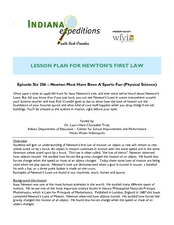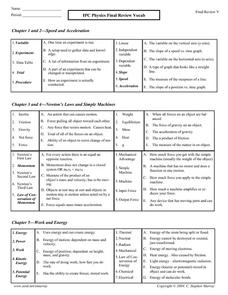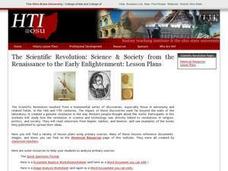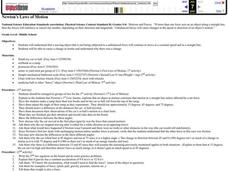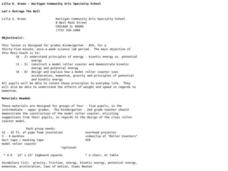Curated OER
Newton: Force and Motion
In this forces worksheet, learners use the equations for acceleration and Newton's second law to learn about different motions and forces. This worksheet has 7 problems to solve.
Curated OER
Newton's Laws
Young scholars give examples of each of Newton's three laws as they occur in everyday experiences. They visually represent and differentiate the difference between a direct proportion and an inverse proportion. Students explain how the...
Curated OER
Newton Must have Been a Sports Fan
Students examine Newton's Laws. In this law of motion lesson, students observe Newton's three laws of physics demonstrated by the teacher. They apply other examples to Newton's first law of inertia.
Curated OER
Newton and his Laws
High schoolers explore Newton's laws, including what they state, and what the intuitive meaning is of the first and third laws.
Curated OER
The Gravity Of It All-Newton's Laws
Students experiment with the concept of Newton's second law of motion. After building a ramp, they determine whether a large marble or a small marble will move farther, based on Newton's law. Students record their data on the provided....
Curated OER
Newton's Laws and Winter Sports
Students investigate past winter Olympic games utilizing any skiing or snowboarding event to take Newton's Challenge. Helpful Web resources are provided and students enjoy learning science laws along with researching Olympic events.
Curated OER
Newton's Laws of Motion Word Search
In this Newton's Laws of Motion word search worksheet, students locate and identify 12 words related to Newton's Laws of Motion within the word search puzzle.
Curated OER
Physical Setting: Physics Exam 2004
Twelve pages of mostly multiple-choice questions comprise this comprehensive New York Regents physics exam. It covers an entire year's worth of physics curriculum and requires about three hours for completion. Review the questions to...
Curated OER
The Physics of Skateboarding
High schoolers are able to analyze gravity as an universal force. They are able to determine how the force of friction retards motion. Students are able to apply Newton's Laws of Motion ot the way the world works.
Curated OER
Describing Motion
In this motion worksheet, students will use Newton's third law of motion to compare the force of objects on Earth with objects on Jupiter. This worksheet has 5 short answer questions.
Curated OER
The Physics of Skateboarding
Students explore Newton's three laws, gravity, momentum, trajectory, projectiles, circular motion, and friction by observing and breaking down skateboard tricks. They view short video clips of Tony Hawk and explain the physics concepts...
Curated OER
Gravitational Acceleration
Students investigate the interdependence of mass and gravitational acceleration using computer simulation. In this physics lesson, students derive the formula for acceleration due to gravity. They calculate air resistance on falling...
Curated OER
Finding Balance
Young scholars examine the relationships between force, mass and balance through the lens of clay sculpture. They discuss the definitions and concepts behind Newton's Third Law of motion then individually apply these principles to the...
Curated OER
IPC Physics Vocabulary Review
In this physics review instructional activity, students review vocabulary words associated with speed, acceleration, Newton's Laws and simple machines, work and energy, magnetism, electricity, and harmonic motion and light. This...
Curated OER
Rocket Me into Space
Students engage in a lesson plan that reinforces rockets as a vehicle that helps us explore outside the Earth's atmosphere by using the principles of Newton's third law of motion. Also, the principles that engineers deal with when...
Curated OER
Crash Course in Flight
High school physicists demonstrate Bernoulli's Principle by blowing on different items and finding that they do not move in the expected direction! They apply Bernoulli's equation to the flight of an airplane. This well-organized lesson...
Curated OER
The Scientific Revolution
Scientists participate in studying how new scientific advances have changed the world. They explain how astronomers have changed the way people view the universe, summarize the advances that were made in chemistry and medicine, and...
Curated OER
Pop Rocket - Trash to Treasure
First off, Newton's laws of motion aren't often taught at 2nd grade, so this lesson may be more appropriate for upper elementary learners. It begins with a discussion and demonstration of the laws of motion, and then has individuals...
Curated OER
Motion, Force, and Gravity
Students write a research paper about human space travel. In this space travel lesson, students watch a video and research issues related to space travel. They use their research to write a paper about whether human space travel should...
Curated OER
Walking on Water
Students use this problem to help them to relate to force vectors: Suspend a meterstick horizontally between two tables. Place a 1kg mass in the middle of the meterstick. Notice the bend of the meterstick. Explain why the meterstick...
Curated OER
Newton's Laws of Motion
Students perform three activities that each demonstrate one of Newton's Laws of Motion. They use a ramp and toy car to demonstrate inertia, calculate acceleration due to gravity, then use a medicine ball and rolling chair to demonstrate...
Curated OER
Let's Outrage the Bull
Students study kinetic and potential energy. In this energy instructional activity, students in grades K-2 understand the differences between kinetic and potential energy. Students in grades 3-5 demonstrate that kinetic and potential...
Curated OER
Force and Motion
Students experiment with force and motion. In this force and motion instructional activity, students test gravity using a variety of objects. Students rotate through a series of stations which use force, motion, friction, and inclines....
Curated OER
Newton's Laws 8th Grade Activities
Eighth graders experiment with Newton's Laws by comparing the falling of different objects with different masses. Students work in teams and rotate through four different stations recording their hypotheses and observations as they go.




